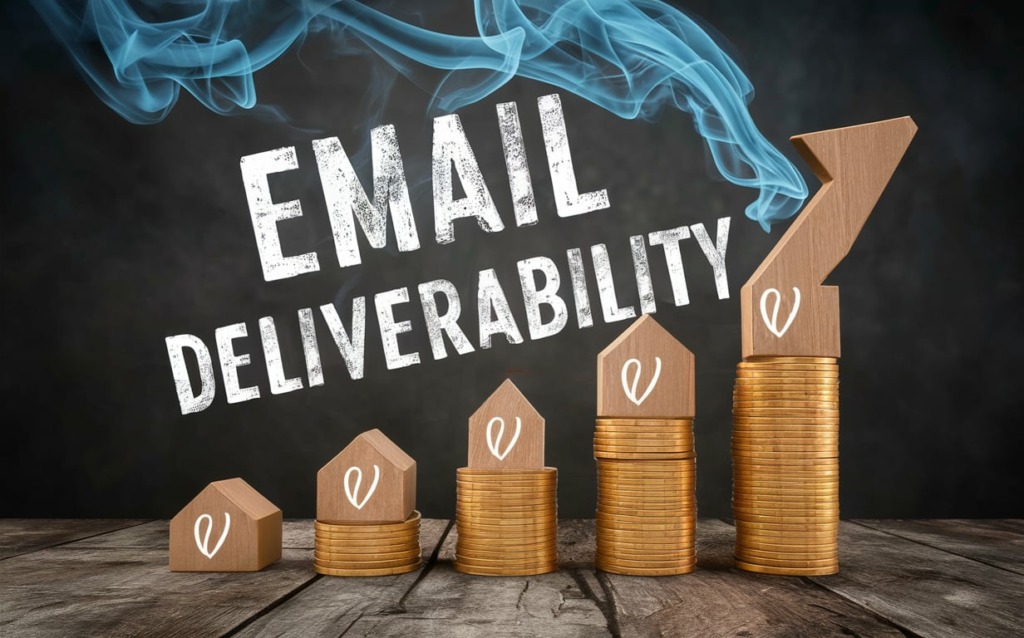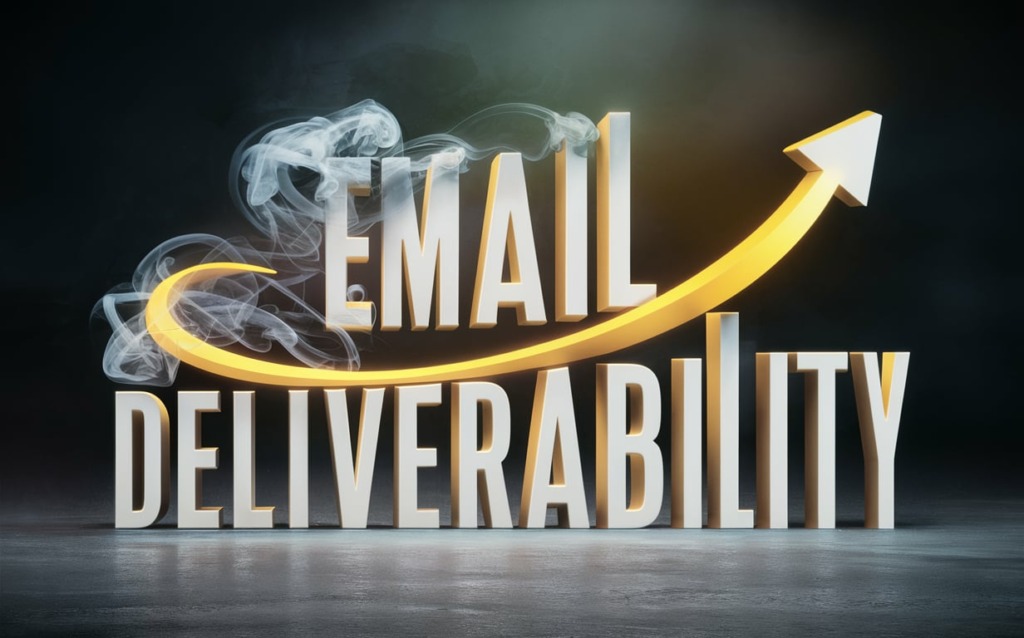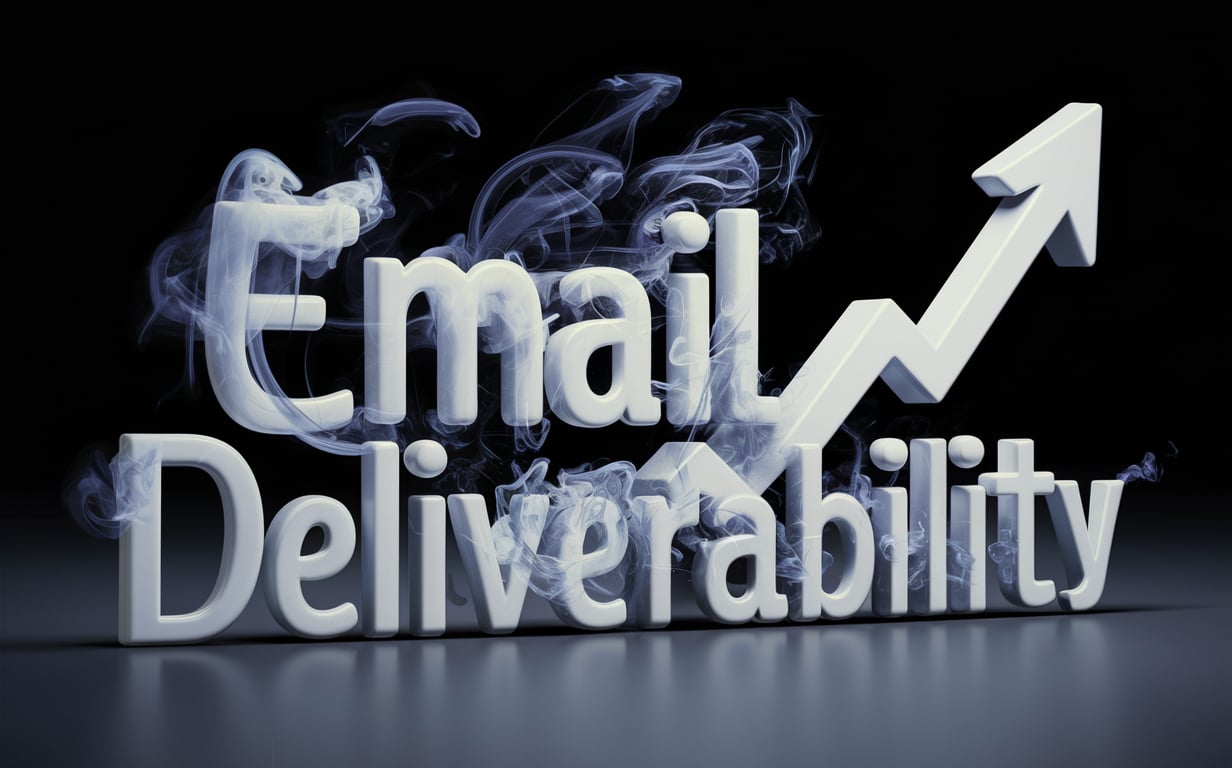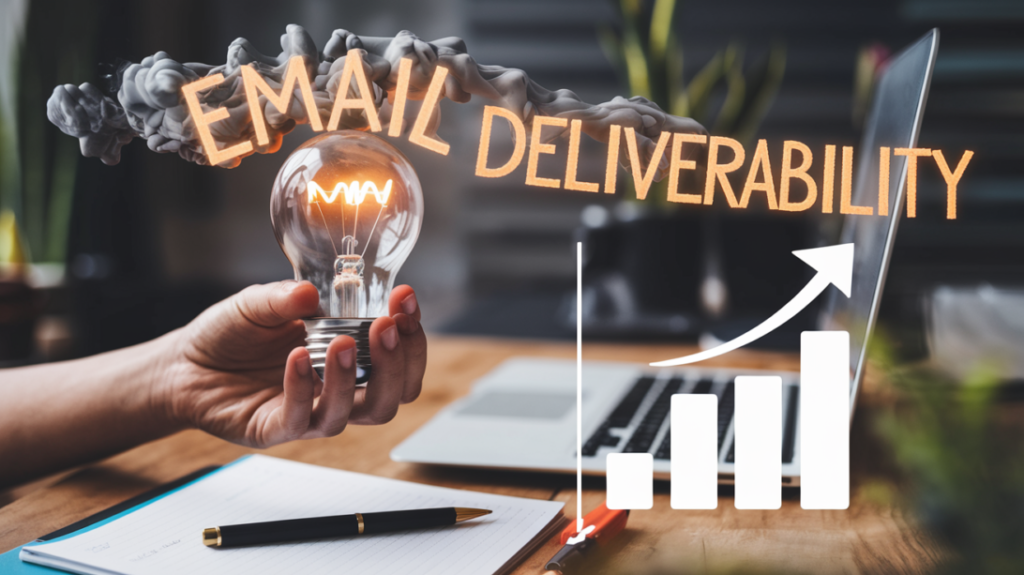Master essential techniques like proper email warming, authentication protocol configuration, bulk list management, and continuous performance benchmarking. We’ll also explore the top specialized tools and managed services for taking your results to the next level.
Boost your inbox placement rates, engagement levels, and return on email investment by following these best practices for deliverability. Say goodbye to lackluster open and click rates – your subscribers’ inboxes are waiting.
Understanding Email Deliverability
Ever sent an email campaign and wondered why so few people opened it? Or noticed some messages go straight to the promotions tab while others make it to the primary inbox?
Getting your emails in front of recipients is harder than it seems. That’s where email deliverability comes in.
Email deliverability refers to the rate at which your messages successfully arrive in your subscribers’ inboxes. It’s one of the most critical factors determining the success of any email marketing effort.
But what exactly impacts deliverability, and why does it matter so much? Let’s break it down.
What is Email Deliverability?
At its core, deliverability is about your emails getting to the right inbox at the right time.
It’s easy to assume that when you hit send, your message will instantly appear for all recipients. Unfortunately, that’s not quite how it works.
There are several potential hurdles between you and your subscribers’ inboxes:
- Spam filters – Both email providers like Gmail and organizations use filters to detect spam and dangerous emails. You need to avoid these to prevent deliverability issues.
- Authentication protocols – SPF, DKIM, and DMARC authenticate you as a legitimate sender. Without proper configuration, your mail may be flagged as untrusted.
- ISP throttling – Internet service providers can throttle or block servers with bad reputations to protect customers from spam.
- Engagement factors – Low open and click rates signal recipients aren’t interested. This reduces future deliverability.
Deliverability refers to navigating these and other obstacles to ensure your email arrives in inboxes reliably.
Why Email Deliverability Matters
Deliverability directly impacts your ability to connect with customers and drive results through email. Here are some of the factors it affects:
- Open and click rates – Your open and click-through rates depend entirely on recipients actually receiving your message. Higher deliverability means more opens.
- Conversions and revenue – Emails that never reach subscribers can’t generate sales. Improving deliverability directly translates to your bottom line.
- Brand reputation – Landing in the promotions tab or spam folder reflects poorly on your brand. Good deliverability builds trust and loyalty.
- Marketing costs – When deliverability suffers, you must send more emails to reach fewer people. This increases your costs.
- Email marketing ROI – With so many factors at stake, poor deliverability drastically reduces your return on investment from email campaigns.
Simply put, deliverability is the key to successful email marketing. That’s why monitoring and optimizing it is so critical.
Measuring Email Deliverability
The first step is tracking deliverability accurately. While not a perfect science, there are a few key metrics that provide visibility:
Open and Click-Through Rates
Open and click-through rates indicate your recipients are actually seeing and engaging with your emails. If these rates decline, it likely signals a deliverability problem.
However, open and click tracking tools don’t provide a full picture, since they only record subscribers who interacted with received emails. You can’t know if messages you sent never arrived.
Bounce Rates
A bounce occurs when an email fails to reach the recipient’s inbox and gets returned to the sender. Hard bounces indicate permanent deliverability failures, while soft bounces are temporary blockages.
Monitoring your overall bounce rate reveals issues impacting deliverability. A high bounce rate means many emails aren’t making it through.
Inbox Placement Rates
Emails don’t just land in the primary inbox or bounce. Many end up filed away into other tabs like promotions or spam.
Analyzing inbox placement rates sheds light on whether your emails are reaching the primary inbox vs. getting filtered. Declining inbox rates signal deliverability problems.
Combining metrics helps paint a complete deliverability picture and identify areas for optimization. Focusing solely on open rates misses the bigger picture.
The key is tracking deliverability continuously over time. That’s the only way to diagnose issues before they drastically impact performance.
Now that you understand what deliverability entails and why it’s vital for email marketing success, let’s explore some of the key factors that influence it.

Key Factors That Impact Deliverability
Deliverability depends on several key factors working together seamlessly. When any part of the process breaks down, your emails suffer.
Let’s explore the core components that determine whether your messages reach the inbox or not.
Sender Reputation
Your domain and IP address’s reputation significantly influences deliverability.
Reputation refers to your ongoing sending patterns and engagement levels. High volumes of spam complaints or bounces damage your sender score.
Email providers maintain internal scoring systems and share data on senders. If you develop a poor reputation with one major player like Gmail, others will likely block you too.
Maintaining a pristine reputation ensures deliverability success. Here are some best practices:
- Keep your list clean by removing inactive subscribers and bounces promptly.
- Monitor spam complaints and investigate the causes.
- Warm up new IP addresses gradually.
- Avoid sudden spikes in sending volume.
- Use double opt-in subscription flows.
- Provide an easy one-click unsubscribe option.
- Ensure engaging, relevant content subscribers want.
With consistent good habits, your reputation will remain stellar across providers.
Email Authentication
Authentication protocols like SPF, DKIM, and DMARC verify your identity as a legitimate sender.
Without proper authentication, recipients may classify your emails as untrusted and divert them to the spam folder automatically.
SPF
Sender Policy Framework authenticates you by allowing only authorized sending servers.
An SPF record lists IPs approved to send email from your domain. Receivers check the record to confirm the originating IP.
If an unauthorized server attempts sending, SPF authentication fails, harming deliverability.
Common issues like permerrors from too many DNS lookups also cause SPF failures. Optimizing your SPF record is essential.
DKIM
DomainKeys Identified Mail adds a digital signature to outbound messages, validating the content integrity.
Your email includes an encrypted DKIM signature tied to your domain. Receivers decrypt and verify this signature to confirm the message is authorized and unmodified.
Any tampering would invalidate the signature, allowing receivers to detect compromised or spoofed emails.
DMARC
Domain-based Message Authentication, Reporting & Conformance builds on SPF and DKIM.
It instructs receivers what to do if either mechanism fails, such as rejecting or quarantining messages.
A DMARC record specifies your authentication policies and reporting preferences. This provides an added layer of protection beyond SPF and DKIM alone.
Implementing all three protocols is critical for deliverability and security. They work together to confirm every message’s authenticity.
Avoiding Spam Filters
Both individual email services and organizations rely on advanced spam filters to protect inboxes.
These filters analyze emails using complex algorithms and rules to catch unwanted messages. Even the most legitimate email can occasionally be flagged as spam.
There are several ways to avoid filters and ensure inbox delivery:
- Send consistently – Don’t just email someone once and disappear. Consistency indicates you’re a reliable sender.
- Avoid spam trigger words – Don’t use phrases commonly found in spam emails that will trigger filters.
- Personalize content – Generic, impersonal text resembles spam. Personalize every message.
- Use double opt-in subscription – Confirm subscriptions to prove subscribers want your emails.
- Limit images and links – These are common in spam emails. Use them sparingly and host images yourself.
- Watch your frequency – Avoid bombarding people with too many emails in a short time.
With mindful sending habits, your emails will safely bypass spam filters unscathed.
Email Content and Design
Even if emails technically get delivered, content and design impact whether recipients actually read and engage with them.
Optimizing these factors leads to higher open and click-through rates:
- Compelling subject – Get creative to make them open your email.
- Relevant, valuable content – Deliver on the subject line’s promise with great info.
- Clear calls-to-action – Provide obvious next steps to click.
- Mobile responsiveness – Over 50% of emails are opened on mobile. Mobile-friendly, easy-scanning layouts are a must.
- Fast load times – Don’t overload emails with big images or files that are slow to load.
- Readable fonts and colors – Avoid hard-to-read color combos and funky fonts.
- Testing for rendering – Ensure your emails look as intended on different devices and email clients.
With great content and design, your emails drive more clicks and conversions once delivered.
Subscriber Engagement
Recipient behavior also impacts deliverability in the long run. Low open and click rates signal subscribers aren’t interested.
When recipients don’t engage, providers may throttlex sending volume to them. This protects customers from unwanted emails.
You can boost engagement with:
- Targeted, personalized messaging
- Segmenting your list by interests
- Regularly refreshing content
- Testing subject lines
- Following up inactive subscribers
Deliverability depends on recipients actually wanting your emails. Keeping their interest is crucial for ongoing inbox placement.
By continually monitoring and optimizing all of these key factors, you can achieve email marketing success. But even when you do everything right, deliverability hurdles still pop up.
Common Deliverability Issues and Solutions
Despite your best efforts, deliverability problems inevitably occur. Here are some of the most common issues and how to address them:
Hard vs. Soft Bounces
Bounces occur when an email fails to reach the recipient’s inbox and gets returned to the sender.
Hard bounces indicate permanent deliverability failures. This usually results from an invalid or deactivated email address. These subscribers should be removed from your list.
Soft bounces are temporary blockages such as when a subscriber’s inbox is full. Retry sending to soft bounced addresses until you receive a hard bounce.
Monitoring bounce rates and types provides visibility into list health issues impacting deliverability. Promptly scrub hard bounces from your list.
Inbox Placement
Delivered emails can still end up filed away into tabs like promotions or spam instead of the primary inbox.
If your inbox placement rates decline, try these troubleshooting tips:
- Improve subject lines – Clear, compelling subjects avoid false spam hits.
- Increase personalization – The more personalized content is, the more legitimate it appears.
- Change the sender name – Sometimes the “from” name triggers filtering if it looks suspicious.
- Test rendering – Ensure emails render properly across different clients.
- Analyze spam test results – Use tools to test spam scores and optimize content.
With adjustments, you can regain your footing in the primary inbox.
SPF Permerrors and DNS Lookup Limits
SPF permerrors result when SPF records exceed the 10 DNS lookup limit. This leads to failed SPF authentication.
Here are some tips to overcome this:
- Consolidate multiple SPF records into one.
- Reduce unnecessary “include” mechanisms.
- Replace lookups with IP addresses when possible.
- Delete unused domain references.
Optimizing your SPF record avoids permerrors and improves authentication.
Slow Email Opens and Render Times
Sluggish email load times frustrate recipients. Quickly fixing display issues is crucial.
- Limit large images – Big image files bog down email loading. Use smaller files or link to images on a webpage instead.
- Minimize CSS – Scale back on unnecessary CSS formatting that can cause latency.
- Check web host uptime – A slow or overloaded web host hampers image loading speed.
With fast rendering, your emails make a great first impression on recipients.
Low Open and Click-Through Rates
If your open and click rates decline, there may be broader deliverability issues at play.
Try these troubleshooting tips:
- Improve subject lines – Rework subject lines that aren’t compelling enough to open.
- Increase personalization – Leverage merge tags and segments to target content.
- Refresh your content – Outdated information gets ignored. Share timely, relevant content.
- Double check your lists – Remove inactive subscribers and bogus email addresses dragging down your rates. Addressing lackluster engagement metrics restores deliverability strength.
By identifying and quickly resolving any deliverability hiccups, you can keep your email marketing program running smoothly.

Improving Deliverability With Warmup
Sending emails from a new domain or account is a high-risk delivery scenario.
Without an established sending reputation, new senders are unknown entities. Email providers tend to err on the side of caution and limit delivery until you demonstrate good habits over time.
This is where email warmup comes in – gradually building your sender reputation to improve deliverability.
What is Email Warmup?
Warmup refers to slowly ramping up the volume of emails sent from a new domain or account. The goal is to establish a reliable sending pattern before full-scale messaging.
Instead of blasting thousands of emails on day one, you send limited batches to a small group of recipients. As long as emails are engaged with and don’t bounce or get marked as spam, sending increments increase over time.
Within a few weeks or months, your domain earns a reputable sender score for excellent deliverability going forward.
How Does Warming Up Work?
There are two core aspects of proper email warmup:
1. Starting with small batch sizes
When warming up a new domain, begin by sending just 10-50 emails per day. Slowly scale up by an additional 50-100 emails as long as prior batches had good engagement and delivery.
2. Warming up over time
Take weeks or months to gradually work up to larger sending volumes. This proves you are committed to quality over quantity. If you rush the process and spike volumes too quickly, deliverability suffers.
The warmup period depends on your target email volume. For example:
- 1,000 emails per day may take 2-4 weeks to ramp up to.
- 10,000+ emails per day could take 8-12 weeks for full warmup.
Patience and discipline are vital – fought deliverability at first to reap the long-term benefits.
Benefits of Warming Up
Taking the time to warming up new domains or accounts gives:
- Improved inbox placement rates – Gradual warmup minimizes the risk of spam folder filtering.
- Increased open and click-through rates – Recipients are more likely to engage with and look forward to your emails after the warmup period.
- Lower bounce rates – Warmup lets you identify and remove undeliverable addresses early before impacting your sender score.
- Reduced hosting costs – Ramping up slowly is easier on your web hosting infrastructure and costs.
- Peace of mind – You can send confidently once your domain establishes a positive reputation.
Warmup is the key to ensuring your emails reliably reach the inbox and get opened.
Email Warmup Best Practices
Following proven warmup workflows is essential:
- Use dedicated IPs – Warm up each new IP address independently starting with low volumes.
- Verify email addresses – Confirm all addresses are valid and able to receive to minimize early bounces.
- Send consistently – Stick to daily schedule sending rather than large batch blasts.
- Create tailored content – Craft engaging messages recipients actually want to receive.
- Use double opt-in – Have recipients reconfirm their interest to ensure you’re not spamming.
- Monitor and adjust – Keep close tabs on engagement, delivery, and complaints. Tweak your approach over time.
With a thoughtful, compliant warmup routine, your sender reputation will flourish.
Email Warmup Tools and Services
You have two options when it comes to warming up domains and accounts – DIY tools or done-for-you warmup services.
Self-Service Warmup Tools
Self-service tools provide technology to manage warmup campaigns yourself. Typically this involves:
- Drip sending features – Automatically increase daily send limits over time.
- Engagement analytics – Track opens, clicks, and more to monitor performance.
- Reputation monitoring – Keep tabs on your domain’s sender rating during warmup.
- Email verification – Confirm address accuracy before warmup kicks off.
- Pre-configured warmup plans – Select duration and final daily send limits.
With the right self-service software, you can orchestrate highly effective account warmup.
Full-Service Warmup Consultants
If you want experts to handle your warmup start-to-finish, consider full-service consultants. Here’s what they typically offer:
- Custom warmup schedule – Based on your specific volumes and risk tolerance.
- Email list verification – Scrub and confirm all addresses are accurate.
- Warmup pool providers – Access high-quality groups open to receiving warmup messages.
- Ongoing performance optimization – Monitoring and tweaks for ideal results.
- Final transition assistance – Help graduating to full-scale sending after warmup.
Full-service takes the workload off your plate for foolproof warmup success.
Key Considerations Choosing a Warmup Tool/Service
As you evaluate warmup options, keep these factors in mind:
- Available sending plans – Make sure they can accommodate your target volumes.
- Technical capabilities – Integration options, analytics depth, and features offered.
- List verification services – Upfront email confirmation is crucial.
- Support and training – Look for providers with robust customer service.
- Reporting and transparency – Ongoing visibility into reputation and metrics is vital.
With the right warmup solution in place, you’ll be ready to launch emails from any new domain or account with confidence.

Monitoring and Analyzing Deliverability
Once your deliverability strategy is in place, the work has just begun. Ongoing monitoring and analysis are crucial for diagnosing issues and continuously optimizing performance.
Why Track Email Metrics?
Email marketing success depends on reliably reaching subscribers’ inboxes and driving engagement. Tracking key metrics makes it possible to:
- Identify problems early – Nip deliverability issues in the bud before they spiral.
- Figure out what’s working – Double down on tactics and campaigns getting results.
- Optimize areas needing improvement – Experiment and iterate to increase open rates, lower bounce rates, etc.
- Benchmark progress over time – Set deliverability goals and evaluate if you’re advancing.
You can only improve what you can measure. Consistent tracking provides the visibility needed to enhance email success.
Deliverability Metrics to Monitor
There are a handful of essential metrics that shed light on your email deliverability health:
Open and Click-Through Tracking
As discussed earlier, open and click-through rates help gauge recipient engagement.
Sudden significant drops in these metrics often indicate deliverability problems. However, high rates alone don’t paint the full picture.
Monitoring these metrics over the long haul reveals the impact of changes you make. Try altering subject lines, content formats, or schedules and track the effects on open and click rates.
Bounce Tracking
Keeping tabs on bounce rates and bounce types (hard vs. soft) provides immediate delivery diagnostics.
A sudden spike in bounces signals something is amiss. Review recent email content for issues. Cross-check bounced addresses against your list for errors.
Ahigh hard bounce rate overall requires list maintenance to remove invalid emails dragging down deliverability. Monitor this metric weekly.
Inbox Placement Monitoring
Don’t just track delivers—pay attention to inbox placement as well.
Seeing the percentage of emails landing in the primary inbox vs. other tabs identifies deliverability roadblocks.
If your primary inbox rate declines, tweak your content to avoid false spam detections. Testing emails against spam filters also helps.
Engagement Monitoring
Engagement metrics indicate how recipients interact with your emails beyond opens and clicks.
Replies, forwarded emails, link clicks, and social sharing all demonstrate higher levels of subscriber interest and trust.
Falling engagement levels signal your content may not resonate. Review recent email topics and test new formats to reinvigorate your audience.
Combining all of these data points creates a comprehensive picture of your deliverability health over time.
Benchmarking Your Email Deliverability
In addition to ongoing monitoring, regularly benchmarking your performance against targets and industry averages is crucial.
Benchmarks identify areas where you excel and gaps needing improvement.
Here are some examples of key performance benchmarks to establish:
Deliverability Rate
Industry Average: 90-95%
Target: Anything above 90%
**Bounce Rate **
Industry Average: 5-10%
Target: Less than 5%
Spam Complaint Rate
Industry Average: Less than 0.1%
Target: 0.05% or lower
Unsubscribe Rate
Industry Average: 0.2% or lower
Target: Under 0.1%
Open Rates
- Financial Industry Avg: 18.17%
- Software Industry Avg: 18.37%
- Set your own target
Click-Through Rates
- Financial Industry Avg: 2.42%
- Software Industry Avg: 2.60%
- Set your own target
Tracking your program’s performance against standards helps maintain an objective view. The benchmarks also give you goals to strive toward.
Make sure to assess reports both month-over-month and year-over-year. Look at factors like seasonal trends in your industry as well.
The most effective way to monitor and benchmark deliverability over time is using dedicated analytics tools.
Deliverability Analytics Tools and Services
To track all the key email marketing metrics, leverage purpose-built analytics tools. There are self-service and fully-managed options available.
Self-Service Deliverability Analytics
Self-service tools empower you to monitor and optimize deliverability internally:
- Customized reporting – Visual reports on all major metrics like opens, clicks, bounces, etc.
- Real-time monitoring – Review stats as campaigns are in progress.
- Historical trend analysis – Track performance over past days, weeks, and months.
- Email previews – See how each campaign looks across different inboxes and devices.
- Spam testing – Submit emails to detect potential spam triggers before sending.
- Inbox placement monitoring – Continuously confirm your sender domain’s reputation.
With the right solutions, you can handle deliverability analytics without expensive consultants. Invest in tools providing robust, actionable data and visualizations to enhance your email success.
Full-Service Deliverability Consultants
If you want deliverability experts to handle the heavy lifting, consider enlisting consultants. Here is what they typically provide:
- Ongoing performance assessments – Monthly reports with action items to optimize deliverability.
- Custom benchmarking – Establish and track metrics aligned to your goals.
- Advanced analytics – Leverage predictive models and machine learning to identify issues.
- Remediation plan development – Receive step-by-step guidance to address problems.
- Testing assistance – A/B test email content for improved performance.
- Sender reputation management – Monitor your domain’s health across major ISPs.
Their deliverability knowledge and tools take your analysis capabilities to the next level.
Closely monitoring performance metrics provides early warnings when deliverability drops. But it’s just one piece of the puzzle—you also need solutions to diagnose and resolve the root causes.

Auditing and Optimizing Deliverability
Once you have deliverability baselines established, the next phase is auditing and enhancement.
Comprehensive audits identify problem areas while optimization services provide solutions tailored to your program. Maintaining an optimized environment ensures maximized email success over the long haul.
Email Deliverability Audits
Audits systematically inspect your entire email program for vulnerabilities and deliverability blockers.
The goal is to surface any weaknesses impacting email placement, engagement, and performance. Think of it as your annual physical for overall domain health.
Here are key components of a deliverability audit:
1. Sender Reputation Review
Confirm your IP and domain reputations across major ISPs. A negative perception by even one major player jeopardizes future delivery.
2. Authentication Protocol Audit
Verify SPF, DKIM, and DMARC are properly implemented with no configuration issues. Flawed protocols undermine email security and deliverability.
3. Content Analysis
Examine email content, links, images, and attachments for factors potentially triggering spam filters. Identify any high-risk components.
4. Design and Rendering Test
Check rendering across major email clients and devices. Ensure your emails appear as intended everywhere.
5. Link Validation
Confirm all links work, lead to relevant content, and use SSL encryption. Broken links hurt engagement.
6. Spam Filter Testing
Run emails through spam detection tools to flag any problems. Tweak content to improve spam test scores.
7. Blacklist Screening
Verify your domain and IP addresses don’t appear on any global or local email blacklists. Listings severely reduce inbox placement.
8. Engagement Analysis
Assess audience interaction levels including open, click-through, and conversion rates. Falling engagement prompts a deeper dive.
9. Infrastructure Review
Inspect web and email hosting infrastructure for issues like slow load times, interruptions, or scalability limits affecting deliverability.
Covering all of these bases paints a comprehensive picture of optimization opportunities to pursue.
Testing and Addressing Deliverability Issues
The audit highlights priority issues to tackle first. Confirm the scope and cause of each problem before acting.
Common tests used to diagnose deliverability issues include:
Spam Filter Testing
Submit a sampling of recent emails to spam detection tools to quantify the severity of filter triggering content. Test email components individually to pinpoint problem areas.
**A/B Testing **
A/B test adjusted content, like different subject lines or email formats. The version scoring higher for deliverability performs better.
Placement Testing
Use tools showing your inbox placement rate for a domain with major ISPs. Declining placement exposes problems needing resolution.
Link Validation
Analyze links for issues like broken URLs, missing SSL encryption, or redirects to shady sites that may get emails marked as spam.
Rendering Tests
Confirm rendering works cross-device and avoid problems like clipped content or intrusive mobile popups harming inbox placement.
Discovering the root causes behind deliverability breakdowns points the way to targeted optimization efforts.
Optimizing Authentication Protocols
With audit findings for SPF, DKIM, and DMARC in hand, take steps to optimize authentication:
Adjust SPF
- Consolidate SPF records
- Reduce DNS lookups through flattening
- Delete unused references causing permerrors
Improve DKIM
- Use larger encryption keys
- Ensure proper TXT record formatting
- Fix misconfigured selector/domain values
Enhance DMARC
- Transition from monitor to reject/quarantine modes
- Require DKIM + SPF pass for alignment
- Boost spam detection with forensic reports
Proper configuration hardens email security and boosts inbox placement rates substantially.
Improving Sender Reputation
To overcome damaged sender reputation, focus on demonstrating stellar habits:
Lower Complaint Rates
- Remove subscribers who mark messages as spam
- Disable inactive or unengaged contacts
- Send more relevant content
Reduce Bounces
- Scrub bad addresses before sending
- Monitor soft bounces and reactivate once resolved
- Quickly remove hard bounces
Increase Engagement
- Write compelling subject lines
- Segment subscribers by interests
- Test message formats like plain text vs HTML
- Collect feedback through surveys
Good standing is built over consistent time through recipient actions. Patience and persistence pay off.
Email Content Analysis and Optimization
Carefully inspect content components jeopardizing deliverability surface during audits:
Subject Lines
Avoid spammy words like “free” or “limited time”. Test curiosity-sparking phrases to drive more opens.
Content
Scale back promotional language and hyperbole that raises spam suspicions. Prioritize valuable information recipients want.
Links
Shorten lengthy URLs with clean link shorteners. Host images yourself rather than linking externally.
Images
Shrink large image file sizes for faster loading. Replace product images not adding value.
Attachments
Consider uploading documents to webpages and linking rather than attaching files directly.
Small tweaks add up, incrementally improving deliverability over the course of campaigns.
Ongoing Performance Benchmarking
The final step is establishing ongoing monitoring to benchmark your progress.
Key Performance Indicators (KPIs)
- Deliverability rate
- Bounce rates
- Complaint rates
- Engagement levels
- Inbox placement rates
Reporting Cadence
- Weekly for key metrics like bounces and spam complaints
- Monthly for detailed performance insights
- Quarterly for longer-term trend analysis
Consistent tracking ensures early identification of new deliverability barriers the moment they crop up. Continual optimization is the only path to email success.
While you can manage much of this yourself, professional services speed the process considerably.
Deliverability Optimization Services
If tackling optimization internally seems overwhelming, leverage service providers. Here are the options:
Deliverability Consultants
Consultants offer strategic guidance and tactical implementation:
- Create audit reports detailing priority focus areas
- Conduct testing to uncover root causes for issues
- Provide step-by-step remediation recommendations
- Directly optimize protocols like SPF records on your behalf
- Develop engaging content and subject lines
- Oversee warmup and ongoing performance
Their expertise acceleratesEmail Deliverability Optimization Services improvement velocity.
Deliverability Software Platforms
Software solutions centralize testing, analytics, monitoring, and optimization:
- Email and link testing tools
- Historical and real-time inbox placement analytics
- Ongoing sender score tracking
- Warmup capabilities for new domains
- Blacklist monitoring
- Spam filter testing and mitigation
- Content analysis with improvement tips
With the right solution, in-house teams can drive continuous optimization.
Key Criteria Evaluating Providers
- Technical expertise guiding optimizations
- Quality of analytics and recommendation
- Ability to benchmark against industry baselines
- Customized action plans aligned to your goals
- Hands-on implementation assistance
- Proactive performance monitoring
Investing in ongoing deliverability management ensures your sender reputation, inbox placement, and engagement metrics remain resilient over the long run. Don’t leave it up to chance.

Email Deliverability Best Practices
Now that you understand what goes into successful deliverability, let’s run through proven best practices to apply:
Authenticate with SPF, DKIM and DMARC
Proper authentication protocol configuration verifies your legitimacy as a sender, avoiding spam folders.
SPF
- Consolidate records to avoid permerrors
- Reference all authorized sending IPs
- Update regularly as senders change
DKIM
- Use 2048-bit encryption keys
- Ensure valid formatting and syntax
- Publish public keys correctly
DMARC
- Start with monitor mode then move to reject or quarantine
- Require DKIM and SPF alignment for authentication
- Request daily or weekly forensic reports
Together, these protocols build sender credibility for smooth inbox delivery.
Monitor Your Sender Reputation
Keep constant tabs on your domain and IP’s status across major email providers.
- Use multi-inbox tests to confirm inbox placement
- Track feedback loops for spam complaints
- Review analytics for increasing bounces
- Verify you’re not on any blocklists
A few black marks can torpedo future email success. Nip issues in the bud.
Craft Relevant, Valuable Content
Emails recipients look forward to receiving avoid spam detection.
- Consistently deliver on what you promise
- Provide personalized value matching interests
- Write crisp, compelling subject lines
- Include educational articles and how-to’s
- Don’t overpromote – focus on usefulness
Quality trumps quantity when it comes to subscriber engagement.
Invest in Quality Lead List Building
The cleanliness of your lists directly impacts deliverability.
- Never purchase lists – grow organically
- Confirm opt-ins with double confirmation
- Verify addresses before importing and sending
- Promptly remove hard bounces after they occur
- Continuously prune inactive subscribers
Bad data inevitably causes headaches. Take the time to build your list right.
Analyze Performance Data
Dig into the numbers to diagnose issues early before they escalate.
- Review weekly engagement and complaint rates
- Analyze monthly inbox placement trends
- Verify major ISP reception monthly
- Conduct quarterly spam testing
- Perform an annual deliverability audit
What you measure, you can improve. But only if you’re measuring.
Test and Optimize Continuously
Keep sharpening your email activities even when things seem to be working.
- A/B test subject lines and content formats
- Analyze and optimize based on engagement data
- Stay on top of spam filter updates
- Audit annually for hidden risks
- Never stop learning and improving
Complacency kills deliverability. The best programs constantly experiment and evolve.
Applying these proven tactics makes achieving long-term email success much more attainable. But deliverability for cold outreach brings its own unique challenges.
Maximizing Deliverability for Cold Email
Cold email sits in dangerous deliverability territory. Recipients don’t know you yet, increasing the spam risk factor.
Here are tips to get your cold messages through:
Gradually Warm Up New Accounts
Don’t suddenly blast recipients from a new domain. Take weeks to gradually build up send volume. This establishes positive sending behavior.
Personalize Outreach
Avoid spam-flagged phrases like “dear sir or madam”. Research prospects and add personal context. Nothing screams spam like a generic cold message.
Ensure Mobile Responsiveness
Many cold emails get opened on smartphones. Avoid intrusive popups and scale back heavy formatting. Simpler is better across mobile devices.
Track Outreach Performance
Monitoring metrics like open rate and inbox placement identifies issues right away during cold email campaigns. Course correct as needed.
Optimize Subject Lines
Nail your subject lines – this drives opens. Test curiosity-sparking phrases and avoid spammy keywords like “free offer” or “act now”.
Rein in Promotional Content
Cold recipients want value upfront before considering your offer. Focus your content on solving their needs vs. bombarding them with pitches. Building trust takes time.
With diligence, cold email can become an impactful lead generation channel without deliverability headaches.
Deliverability is a multifaceted pursuit requiring focus across many interlinking components. But sticking to core best practices makes the process approachable.
Let’s finish off by exploring some solutions to help implement a robust deliverability strategy.

Solutions for Deliverability Success
With a solid understanding of what effective deliverability entails, let’s explore some solutions to get you started.
Top Deliverability Software Tools
Software tools provide technology to monitor, analyze, and optimize your email deliverability. Top solutions offer:
Email Testing and Monitoring
- Spam testing before sending
- Inbox placement monitoring
- Email and link validation
- Real-time traffic analytics
Deliverability Analytics
- Customized reporting across all metrics
- Historical performance tracking
- Real-time alerting when issues surface
Domain Health Management
- Sender reputation monitoring
- Authentication optimization
- Blacklist monitoring
- Feedback loop integration
List Management
- Email address verification
- Bounce processing and scrubbing
- Automated inactive subscriber removal
Optimization Recommendations
- Content analysis with improvement tips
- A/B testing capabilities
- Personalization and segmentation
With the right software stack, you can take total control over maximizing your email deliverability in-house.
Managed Deliverability Services
For those wanting deliverability handled entirely, consider enlisting managed service providers. Here’s what they offer:
Consulting Services
- Quarterly performance assessments
- Custom benchmark goal-setting
- Remediation recommendations
- Content optimization assistance
Deliverability Platform Access
- Full management of their solution stack
- Ongoing monitoring and issue identification
- Daily platform administration and upkeep
Omnichannel Inbox Placement
- Ensuring optimal inbox placement across email, mobile, and ISPs
- Routing emails for maximum engagement
Proactive Optimization
- Continuous testing and improvements
- Staying on top of algorithm changes
- Suggesting innovations to bolster performance
Their expertise relieves your team of the deliverability burden.
Email Warmup Tools and Consultants
Specialist warmup solutions help launch new domains and accounts safely:
Self-Service Warmup Tools
- Gradually increase daily send limits
- Provide target IP warm up pools
- Give visibility into progress and metrics
- Automatically ramp up send volume
Full-Service Warmup Consultants
- Handle your complete warmup process
- Give strategic advice tailored to your needs
- Leverage high-quality warmup recipient pools
- Monitor and optimize throughout
Either option effectively builds positive sender reputation for new domains.
Comparing Deliverability Providers
With many potential partners available, focus on these key considerations:
Technical Capabilities
Assess available tools, analytics depth, features, and whether they integrate with your other platforms.
Service Expertise
Review advisor experience, optimization recommendations, and guidance quality if pursuing managed services.
Pricing
Calculate total cost based on your list size, email volume, and optional add-ons to find the best value.
Support Resources
Look for solid documentation, thorough training, and different tiers of customer support.
Scalability
Ensure the provider can grow with you across small business, mid-market, and enterprise-level needs.
Once you’ve narrowed down the top contenders, dive deeper before deciding.
Choosing the Right Deliverability Provider
When evaluating final options, get clear answers on these aspects:
Provider Features to Look For
- Do you offer email authentication configuration and optimization?
- How do you monitor inbox placement across major ISPs?
- What deliverability analytics and reporting do you provide?
- Can you audit our content for spam triggers?
- How can we preview email rendering?
Assess Your Budget and Needs
- Are the core features we need included in your lowest pricing tier?
- Is there flexibility to pay only for the capabilities we want?
- Do you offer any discount for annual commitments?
- What is your payment and cancellation policy?
Determine Scalability Requirements
- We plan to scale from X to Y emails per month – can you handle that volume?
- Is there an easy way to upgrade plans as our needs evolve?
- Do you offer enterprise options beyond basic plans if we grow exponentially?
Evaluate Their Support and Account Management
- What does technical and strategic support look like?
- Do you assign an account manager for onboarding help?
- Is there email, chat, phone, and ticket support available?
- How responsive is the support team to inquiries?
Don’t Forget Deliverability Guarantees
- Do you guarantee a certain deliverability rate or have an SLA?
- If our deliverability with you drops below X, what happens?
- Is there a refund, credit, or extension policy for missed SLAs?
- What steps will you take to diagnose and remedy deliverability problems?
Vetting providers thoroughly upfront ensures the best fit partner to drive results and align to your growth trajectory.
With a robust deliverability strategy powered by the right solutions, your email marketing success is no longer up to chance. You’ll have the tools and knowledge needed to Clear the deliverability hurdles standing between your brand and subscribers’ inboxes.

Key Takeaways
Deliverability may seem complicated on the surface, but just remember these core lessons:
- Monitor engagement and inbox placement rates continuously – this is your deliverability dashboard.
- Tackle issues as soon as metrics decline – nip problems before they scale up.
- Warm up new accounts gradually over weeks or months before full-scale sending.
- Optimize your SPF, DKIM, and DMARC records – flawed authentication torpedoes delivery.
- Analyze content thoroughly and tweak anything triggering spam filters.
- Keep your email list 100% clean and verified – bad data guarantees failure.
- Test across devices and email clients – You can only fix rendering issues you see.
- Learn your sender reputation status – one complaint can ruin your domain’s good name.
- Benchmark against competitors and industry averages to strive for excellence.
- Enlist help scaling optimization efforts as needed – this is a team sport.
- Never stop testing and improving – even the best strategy needs continuous refinement.
While many factors impact success, staying focused on fundamentals is half the deliverability battle.
Now you have a solid blueprint for analyzing, benchmarking, enhancing, and monitoring your email deliverability. The rest comes down to diligent execution.
With a steady, disciplined approach, you can overcome any deliverability obstacle and ensure your messages consistently reach subscriber inboxes.
Frequently Asked Questions
Still have some deliverability questions? Here are answers to the most common ones:
What causes emails to land in spam folders?
Potential triggers include harmful content, flawed SPF/DKIM/DMARC records, low engagement rates, spam filter words, and low sender reputation.
How often should you monitor email metrics?
Critical metrics like bounces and spam complaints should be reviewed weekly. In-depth campaign performance analysis monthly. Quarterly and annual benchmarks help too.
What is an acceptable email deliverability rate?
Delivery rates above 90% are considered decent while 95% and above is excellent. Strive for 98% or more for the best results.
When does an email address need warming up?
Any new domain or email account that you’ll be sending larger volumes from should be warmed up first. This builds positive reputation to avoid future blocking.
How long does proper email warmup take?
For moderate volume increases, warmup usually takes 2-4 weeks. For major volume spikes of 10x or more, plan for 8-12 weeks of gradual ramp up.
Can you speed up the warmup process?
Patience is required. Rushing the process by spiking send volume too quickly will harm your domain reputation, undermining effectiveness. Take it slow.
How often should you conduct a deliverability audit?
Annual audits are recommended for an in-depth health check. Ongoing spot checks every quarter help troubleshoot issues as they emerge.
What’s the average industry email engagement rate?
Average open rate is 18-20% across industries. Click-through rate ranges from 2-3%. Review competitor and industry benchmarks to set target goals.
What happens if email authentication records are misconfigured?
Improper SPF, DKIM, or DMARC records lead to authentication failure, signaling to receivers that emails are untrustworthy and likely spam.
When should you use a third-party deliverability provider vs handling internally?
If your team lacks deliverability expertise, outsourcing to specialists makes sense. With experience, internal tools can offer greater customization and control.
What results can you expect from focusing on deliverability optimization?
Target improvements of: inbox rates above 90%, less than 5% bounces, under 0.1% complaints, 0.5-1% increase in engagement rates monthly.

